First Impressions of Phenomenal Phnom Penh
I will be somewhat frank in admitting that I was not entirely prepared for Phnom Penh. While I had a general idea of the city, I did not quite understand how entirely foreign most aspects of daily life would feel. This was very quickly impressed upon me as I tried very hard to walk through traffic, a learned skill, that includes sharing the sidewalks and roads with a myriad of motorcycles, tuk tuks, bicycles, and cars. Crossing intersections is its own unique challenge too, where there are hardly ever any traffic lights (and even if there are, they are not followed).
However, I am pleased to say that I have adjusted quickly! Phnom Penh is fantastic city that is vibrant, fascinating, and, above all else, kind. I am perpetually awed by the hospitality of those around me. Furthermore, I’ve even become accustomed to the traffic! What makes Phnom Penh feel initially hectic and foreign is entirely a part of its charm. After just one day in the city, I was weaving through traffic like a pro, buying fruit from street vendors, and so on. While I haven’t quite worked up the courage to buy a durian, I will admit, I am a bit tempted by the novelty.
Arriving in Cambodia was no easy feat. My trip started with a flight from Dallas to San Francisco, then a fourteen-hour flight from San Fran to Gaungzhou, China. From there, I had another three-hour flight to Phnom Penh. Because of the twelve-hour time change, I effectively lost two whole days to air travel. Before leaving, I had a scant three days to spend with my family and pack.
Upon arrival at Phnom Penh's international airport, I was met by Vin, ODC’s Research and Partnership Officer, and another American legal intern, Jean, who had also just arrived. I was wearing a sweater and jeans, which was ill-advised, to say the least. Phnom Penh gets to 95 degrees Fahrenheit by midday, plus roughly 70% humidity. So, my sweater was effectively soaked in sweat within minutes (and I do mean soaked; it was not pretty!). Luckily, my apartment has air conditioning, which I found with a bit of luck and Vin’s help.
My first two full days in Phnom Penh were devoted to being a tourist. Waking up early to beat the heat, I grabbed a tuk tuk (also known as an auto rickshaw) and headed to the city center to see the Royal Palace and the National Museum. The Royal Palace is extraordinary, with ornate golden roofs and, in the case of the Silver Pagoda, a floor made of over 5,000 silver tiles (a very appropriately named pagoda). Built in the 1860’s, most of the Royal Palace is actually off-limits, as it is the living quarters of King Sihamoni, who is incidentally celebrating his 65th birthday this year. I then went next door to the National Museum, which houses one of the largest collections of Khmer art in the world.
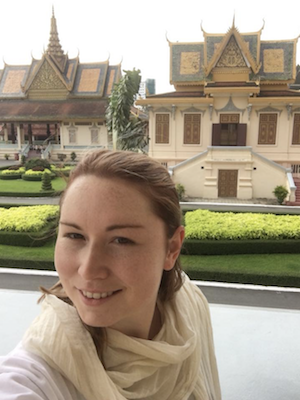
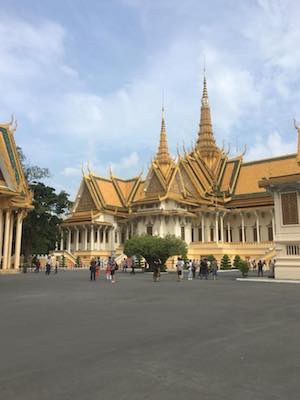
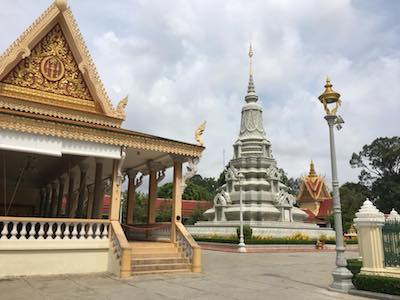
By now, it was only 11 AM and I was drenched in sweat (neither the Royal Palace nor the National Museum have air conditioning, save for maybe one or two rooms). I decided to cool off and have a bite to eat at a nearby restaurant, Friends, which helps train marginalized youth to have a career in the hospitality industry. In Cambodia, food is incredibly good and incredibly cheap. My meal at Friends was a bit pricey, by which I mean a mere seven dollars (and it went to good cause). For that price, I got an amazing, entrée-sized plate of pork belly and a drink. Most of my meals so far in Cambodia, have ranged from $0.75 to $5.00. All have been excellent and healthily proportioned. After lunch, I took another tuk tuk to a Buddhist wat, Wat Phnom, which sits on the only hill in Phonm Penh. At that point, it was 1 PM and basically too hot to even consider remaining outside, so I headed home for the afternoon.
Day two was significantly more somber. After seeing Cambodia’s healthy appreciation for ornate architecture and gilded roofs, I decided it was important to see the country’s more depressing history. Again waking up early, I walked to Tuol Sleng Genocide Museum, a former high school in the heart of the city that was converted into an interrogation center by the Khmer Rouge in 1975. Renamed S-21, approximately 17,000 men, women, and children were brought to the center by the Khmer Rouge, of which there are only seven known survivors.
In college, I was fortunate enough to study abroad in Eastern Europe for a month and take a course on the psychology of the holocaust. The class was incredibly impactful for me personally, as we went to numerous holocaust museums and concentration camps. Going to Tuol Sleng was similarly impactful but, in some ways, even more disturbing than the Nazi camps I visited. S-21 is very much unchanged and unsantizied from when it was liberated in 1979, complete with all the harrowing evidence of what happened there. Additionally, the evidence (photographs, artist’s renditions, actual interrogation “equipment,” etc.) is incredibly graphic. Much like the Nazis, the Khmer Rouge were meticulous record-keepers, photographing every new prisoner along with their assigned number. Several former cells are lined with literally hundreds of these haunting photos. I left Tuol Sleng a bit dizzy and overwhelmed, retiring to my air conditioning for the rest of the day.
On a less a somber note, the neighborhood I live in is fantastic. It’s close to the Russian Market (so named for the high concentration of Russian expats that used to here in the 80’s), so the streets are lively and filled with shops, street vendors, restaurants, and everything else you can imagine. Pretty much every square inch of sidewalk is taken up with something. The market itself is a singular block, aisles crammed with clothing, electronics, you name it. Just southeast of the market are several streets with many western-style cafes, catering heavily to expats and tourists (who are often laden with shopping bags from the market). In the evening, when the temperature begins to drop ever so slightly, the neighborhood becomes a hive of activity, with children playing in the streets and families flocking to the long row of street food vendors. If I have no evening plans, I like to wander through the market lazily, enjoying the fresh air and community before settling into a café for dinner.
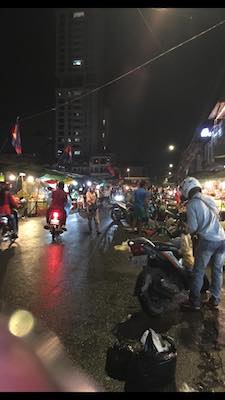
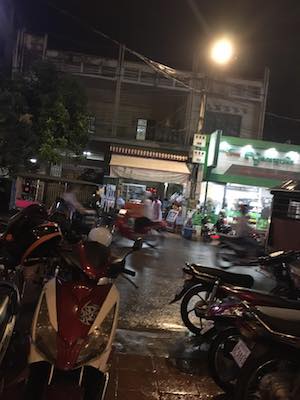
On Sunday night, before my first day of work, I met two other ODC interns, Malicia and Lennart. Until then, I had been effectively traveling alone with only a good book to keep me company. As such, I was wildly relieved to have some company, make some friends, and learn a bit more about the ODC work environment before Monday morning. Together, we went to the park next to the Royal Palace, where there is an ongoing effort to weave the world’s longest krama. A krama is a checkered scarf that is unique to Khmer culture and worn very often by men and women alike; thus, this six month project is designed to highlight Cambodia’s culture and history in a fun and accessible manner. In fact, I believe anyone can sign up to weave a few centimeters, though it looks challenging on the giant loom. When eventually completed, the red and white krama will be 1,000 meters long, breaking the world record.
It was neat seeing the massive traditional loom being used to weave the krama, as well as the various exhibits on traditional Khmer crafts. Excitingly, later in the evening, it appeared that some local children were going to showcase some kind of choreographed martial arts. We all grabbed a front row seat on the grass, somewhat eager. However, after twenty minutes without development, rain clouds began to loom. Hungry, our group trundled off to a nice Burmese restaurant.
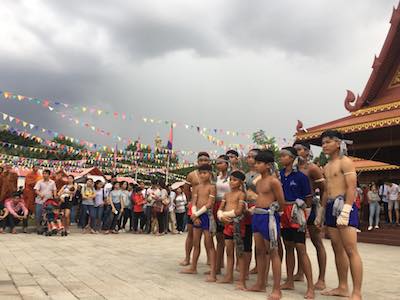
On Monday, I eventually broke down and bought a Cambodian phone. My iPhone won’t take a Cambodian SIM card, so for a while I had no access to maps, facebook, etc. while I was cruising the town. My new phone is a gargantuan Samsung Galaxy Mega, complete with its own Cambodian cell phone number and a bunch of Korean apps I don’t understand (it’s used of course). Here, there are two main cell carriers, Smart and Cellcard. Many Cambodians have two cellphones, one for each carrier, or manage to put both numbers on one phone. I didn't bother to puzzle that out, so I arbitrarily joined the Smart network (which seemed Smart at the time).
Anyway, what’s actually critical about getting a Cambodian cell phone relates to tuk tuks. In Cambodia, you can walk to any street corner and find a tuk tuk with no problem. In fact, if you look like a tourist, like I do, you’ll be offered a tuk tuk ride practically every thirty seconds. However, with tuk tuks, you have to 1) tell the driver where you are going, which is sometimes quite the challenge, and 2) haggle the price. You always lose haggling, even if you think you're winning. However, if you have a cell phone, you can get a tuk tuk, much like how one orders an Uber or Lyft, on an app called Pass App. With Pass App, giving the driver directions is the press of a button and there’s no haggling; the price is always calculated by the app. The results speak for themselves: after I got my phone, my tuk tuk rides generally cost 50% less. In other words, getting a phone significantly improved my quality of life in Phnom Penh!
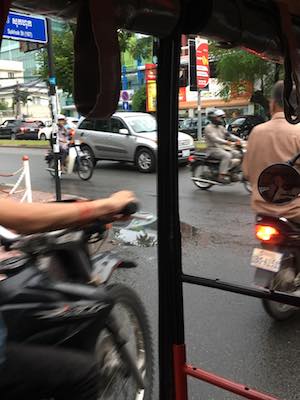
So far, I’ve only worked two days with Open Development Cambodia, which focuses on providing data indicating the development trends of Cambodia. One of ODC’s biggest commitments is to provide that data in an objective manner, with context but without any editorial comment. My first task, as an ODC legal intern, has been to update the Legal Aid and Legal Professions pages on the website. As such, my first few days in the office have largely been researching Cambodia’s legal system, how legal aid is provided, and how the Bar Association of the Kingdom of Cambodia (BAKC) regulates attorneys. Unfortunately, legal aid is quite limited in Cambodia, despite the fact that access to an attorney (if one cannot be afforded) is enshrined in Cambodia’s constitution. NGOs pick up much of the slack, but many provincial locations still lack even one legal aid attorney.
Therefore, my first two days with ODC have been lots and lots of reading (not so different from law school, right?), although I did take a break to record the English voiceover for an unrelated ODC video, which was fun. On Wednesday, Try, the Executive Director of ODC, returns from Laos. When he arrives, I’ll have a clearer outline of my summer project and will, hopefully, be able to put my research to good use. Until then, I’ve been doing my best to prepare and, of course, snacking on the office’s afternoon supply of mango slices.